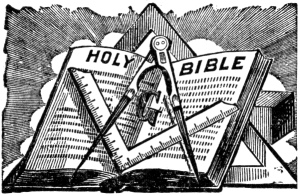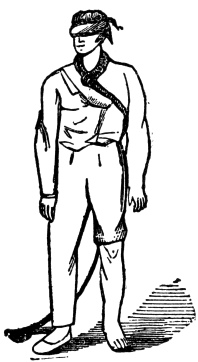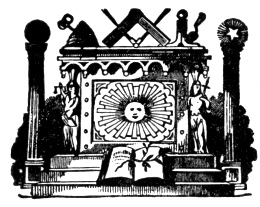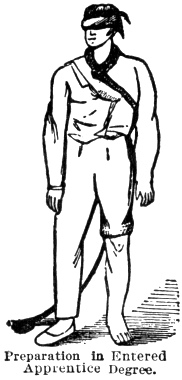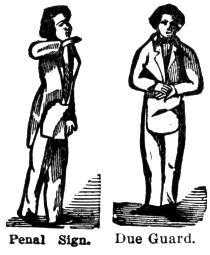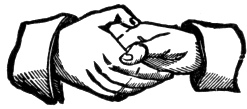by Moe | Aug 26, 2011 | Illustrations of Masonry
“Have you ever worked as a Fellow Craft Mason?”
Ans. “I have in speculative; but our forefathers wrought both in speculative and operative Masonry.”
“Where did they work?”
Ans. “At the building of King Solomon’s temple, and many other Masonic edifices.”
“How long did they work?”
Ans. “Six days.”
“Did they not work on the seventh?”
Ans. “They did not.”
“Why so?”
Ans. “Because in six days God created the heavens and
p. 66
the earth, and rested on the seventh day; the seventh day, therefore, our ancient brethren consecrated as a day of rest from their labors; thereby enjoying more frequent opportunities to contemplate the glorious works of creation, and adore their great Creator.”
“Did you ever return to the sanctum sanctorum, or holy of holies, of King Solomon’s temple?”
Ans. “I did.”
“By what way?”
Ans. “Through a long porch or alley.”
“Did anything particular strike your attention on your return?”
Ans. “There did, viz.: two large columns, or pillars, one on the left hand and the other on the right.”
“What was the name of the one on your left hand?”
Ans. “Boaz, to denote strength.”
“What was the name of the one on your right hand?”
Ans. “Jachin, denoting establishment.”
“What do they collectively allude to?”
Ans. “A passage in Scripture wherein God has declared in his word, ‘In strength shall this house be established.'”
“What were their dimensions?”
Ans. “Eighteen cubits in height, twelve in circumference, and four in diameter.”
“Were they adorned with anything?”
Ans. “They were, with two large Chapiters, one on each.”
“Were they ornamented with anything?”
Ans. “They were, with wreaths of net-work, lily-work, and pomegranates.”
“What do they denote?”
Ans. “Unity, peace, and plenty.”
“Why so?”
Ans. “Net-work, from its connection, denotes union; lily-work, from its whiteness and purity, denotes peace; and pomegranates from the exuberance of its seed, denotes plenty.”
“Were those columns adorned with anything further?”
Ans. “They were, viz.: two large globes or balls, one of tack.
p. 67
“Did they contain anything?”
Ans. “They did, viz.. All the maps and charts of the celestial and terrestrial bodies.”
“Why are they said to be so extensive?”
Ans. “To denote the universality of Masonry, and that a Mason’s charity ought to be equally extensive.”
“What was their composition?”
Ans. “Molten or cast brass.”
“Who cast them?”
Ans. “Our Grand Master, Hiram Abiff.”
“Where were they cast?”
Ans. “On the banks of the river Jordan, in the clay ground between Succoth and Zaradatha, where King Solomon ordered these and all other holy vessels to be cast.”
“Were they cast sound or hollow?”
Ans. “Hollow.”
“What was their thickness?”
Ans. “Four inches or a hand-breadth.”
“Why were they cast hollow?”
Ans. “The better to withstand inundations and conflagrations; were the archives of Masonry and contained the constitution, rolls and records.”
“What did you next come to?”
Ans. “A long, winding stair-case, with three, five, seven steps or more.”
“What do the three steps allude to?”
Ans. “The three principal supports in Masonry, viz.: wisdom, strength and beauty.”
“What do the five steps allude to?”
Ans. “The five orders in architecture, and the five human senses.”
“What are the five orders in architecture?”
Ans. “The Tuscan, Doric, Ionic, Corinthian and Composite.”
“What are the five human senses?”
Ans. “Hearing, seeing, feeling, smelling and tasting, the first three of which have ever been deemed highly essential among Masons: hearing, to hear the word; seeing, to see the sign, and feeling, to feel the grip, whereby one Mason may know another in the dark as well as the light.
p. 68
“What do the seven steps allude to?”
Ans. “The seven sabbatical years, seven years of famine, seven years in building the Temple, seven golden candlesticks, seven wonders of the world, seven planets; but more especially the seven liberal arts and sciences, which are grammar, rhetoric, logic, arithmetic, geometry, music and astronomy. For these and many other reasons the number seven has ever been held in high estimation among Masons.”
“What did you next come to?”
Ans. “The outer door of the middle chamber of King Solomon’s Temple, which I found partly open, but closely tyled by the Junior Warden.”
Moe is the founder of GnosticWarrior.com. He is a father, husband, author, martial arts black belt, and an expert in Gnosticism, the occult, and esotericism.
by Moe | Aug 26, 2011 | Illustrations of Masonry
The traditional account of the death and several burials, and resurrection of Hiram Abiff, the widow’s son [as hereafter narrated], admitted as facts, this degree is certainly very interesting. The Bible informs us that there was a person of that name employed at the building of King Solomon’s Temple; but neither the Bible, the writings of Josephus, nor any other writings, however ancient, of which I have any knowledge, furnish any information respecting his death. It certainly is very singular, that a man so celebrated as Hiram Abiff, was an arbiter between Solomon, king of Israel, and Hiram, king of Tyre, universally
p. 70
acknowledged as the third most distinguished man then living, and in many respects the greatest man in the world, should pass off the stage of action in the presence of King Solomon, three thousand three hundred grand overseers, and one hundred and fifty thousand workmen, with whom he had spent a number of years, and neither King Solomon, his bosom friend, nor any other among his numerous friends even recorded his death or anything about him. I make these remarks now, hoping that it may induce some person who has time and capacity to investigate the subject, and promulgate the result of his investigation. I shall let the subject rest where it is, at present; it is not intended that it should form any part of this little volume. The principal object of this work is to lay before the world a true history of Freemasonry, without saying anything for or against it.
A person who has received the two preceding degrees, and wishes to be raised to the sublime degree of a Master Mason, is [the lodge being opened as in the preceding degrees] conducted from the preparation room to the door,
[the manner of preparing him is particularly explained in the lecture] where he gives three distinct knocks, when the Senior Warden rises and says, “Worshipful, while we are peaceably at work on the third degree of Masonry, under the influence of humanity, brotherly love, and affection, the door of our lodge appears to be alarmed.”
The Master to the Senior Deacon, “Brother Senior, enquire the cause of that alarm.”
The Senior Deacon then steps to the door and answers the three knocks that have been given by three more: [these knocks are much louder than those given on any occasion, other than that of the admission of candidates in the several degrees] one knock is then given without and
p. 71
answered by one within, when the door is partly opened and the Junior Deacon asks, “Who comes there? Who comes there? Who comes there?”
The Senior Deacon answers, “A worthy brother who has been regularly initiated as an Entered Apprentice Mason, passed to the degree of a Fellow Craft, and now wishes for further light in Masonry by being raised to the sublime degree of a Master Mason.”
Junior Deacon to Senior Deacon, “Is it of his own free will and accord he makes this request?”
Ans. “It is.”
Junior Deacon to Senior Deacon, “Is he duly and truly prepared.”
Ans. “He is.”
Junior Deacon to Senior Deacon, “Is he worthy and well qualified?”
Ans. “He is.”
Junior Deacon to Senior Deacon, “Has he made suitable proficiency in the preceding degrees?”
Ans. “He has.”
Junior Deacon to Senior Deacon, “By what further rights does he expect to obtain this benefit?”
Ans. “By the benefit of a pass-word.”
Junior Deacon to Senior Deacon, “Has he a pass-word?”
Ans. “He has not, but I have got it for him.”
The Junior Deacon to the Senior Deacon, “Will you give it to me.?”
The Senior Deacon then whispers in the ear of the Junior Deacon, “Tubal Cain.”
Junior Deacon says, “The pass is right. Since this is the case, you will wait till the Worshipful Master be made acquainted with his request and his answer returned.”
Moe is the founder of GnosticWarrior.com. He is a father, husband, author, martial arts black belt, and an expert in Gnosticism, the occult, and esotericism.
by Moe | Aug 26, 2011 | Illustrations of Masonry
“Are you a Master Mason”
Ans. “I am—try me, prove me—disprove me if yon can.”
“Where were you prepared to be made a Master Mason?”
Ans. “In a room adjacent to the body of a just and lawfully constituted lodge of such, duly assembled in a room representing the sanctum sanctorum, or holy of holies, of King Solomon’s Temple.”
“How were you prepared?”
Ans. “By being divested of all metals; neither naked nor clothed; barefoot nor shod; with a cable-tow three times about my naked body; in which posture I was conducted to the door of the lodge, where I gave three distinct knocks.”
“What did those three distinct knocks allude to?”
Ans. “To the third degree of Masonry; it being that on
p. 91
which I was about to enter.”
“What was said to you from within?”
Ans. “Who comes there? Who comes there? Who comes there?”
“Your answer?’
Ans. “A worthy brother who has been regularly initiated as an Entered Apprentice Mason, passed to the degree of a Fellow Craft, and now wishes for further light in Masonry, by being raised to the sublime degree of a Master Mason.”
“What further was said to you from within?”
Ans. “I was asked if it was of my own free will and accord I made that request; if I was duly and truly prepared; worthy and well qualified, and had made suitable proficiency in the preceding degrees; all of which being answered in the affirmative, I was asked by what further rights I expected to obtain that benefit.”
“Your answer?”
Ans. “By the benefit of a pass-word.”
“What is that pass-word?”
Ans. “Tubal Cain.”
“What next was said to you?”
Ans. “I was bid to wait till the Worshipful Master in the east was made acquainted with my request and his answer returned.”
“What followed after his answer was returned?”
Ans. “I was caused to enter the lodge on the two extreme points of the compass, pressing my naked right and left breasts, in the name of the Lord.”
“How were you then disposed of?”
Ans. “I was conducted three times regularly round the lodge, and halted at the Junior Warden in the south, where the same questions were asked and answers returned as at the door.”
“How did the Junior Warden dispose of you?”
Ans. “He ordered me to be conducted to the Senior Warden in the west, where the same questions were asked and answers returned as before.”
“How did the Senior Warden dispose of you?”
Ans. “He ordered me to be conducted to the Worshipful Master in the east, where by him the same questions were asked, and answers returned as before, who likewise demanded
p. 92
of me from whence I came, and whither I was traveling.”
“Your answer?”
Ans. “From the east and traveling to the west”
“Why do you leave the east, and travel to the west?”
Ans. “In search of light.”
“How did the Worshipful Master then dispose of you?”
Ans. “He ordered me to be conducted back to the west, from whence I came, and put in care of the Senior Warden, who taught me how to approach the east, by advancing upon three upright, regular steps to the third step, my feet forming a square and my body erect at the altar before the Worshipful Master.”
“What did the Worshipful Master do with you?”
Ans. “He made an obligated Master Mason of me.”
“How?”
Ans. “In due form.”
“What was that due form?”
Ans. “Both my knees bare bent, they forming a square; both hands on the Holy Bible, Square and Compass; in which posture I took upon me the solemn oath or obligation of a Master Mason.”
“After your obligation, what was said to you?”
Ans. “What do you most desire?”
“Your answer?”
Ans. “More light.”
[The bandage round the head is now dropped over the eyes.]
“Did you receive light?”
Ans. “I did.”
“On being brought to light on this degree, what did you first discover?”
Ans. “Three great lights in Masonry, by the assistance of three lesser, and both points of the compass elevated above the square, which denoted to me that I had received, or was about to receive all the light that could be conferred on me in a Master’s Lodge.”
Moe is the founder of GnosticWarrior.com. He is a father, husband, author, martial arts black belt, and an expert in Gnosticism, the occult, and esotericism.
by Moe | Aug 26, 2011 | Illustrations of Masonry
“Did you ever return to the sanctum sanctorum or holy of holies of King Solomon’s Temple?”
Ans. “I did.”
“Was there anything particular took place on your return?”
p. 94
Ans. “There was, viz.: I was accosted by three ruffians, who demanded of me the Master Mason’s word.”
“Did you give it to them?”
Ans. “I did not, but bid them wait with time and patience till the Grand Lodge assembled at Jerusalem; and then, if they were found worthy, they should receive it; otherwise they could not.”
“In what manner were you accosted?”
Ans. “In attempting to retire to the south gate, I was accosted by one of them, who demanded of me the Master Mason’s word, and on refusing to comply with his request he gave me a blow with the twenty-four inch gauge, across my breast, on which I fled to the west gate, where I was accosted by the second, with more violence, and on my refusing to comply with his request he gave me a severe blow with the square, across my breast, on which I attempted to make my escape at the east gate, where I was accosted by the third, with still more violence, and on my refusing to comply with his request he gave me a violent blow with the common gavel on the forehead, and brought me to the floor.”
“Whom did you represent at that time?”
Ans. “Our Grand Master, Hiram Abiff, who was slain at the building of King Solomon’s Temple.”
“Was his death premeditated?”
Ans. “It was, by fifteen Fellow Crafts, who conspired to extort from him the Master Mason’s word; twelve of whom recanted, but the other three were base enough to carry their atrocious designs into execution.”
“What did they do with the body?”
Ans. “They carried it out at the east gate of the Temple and buried it till low twelve at night, when they three met, agreeable to appointment, and carried it a westerly course from the Temple, and buried it under the brow of a hill in a grave six feet due east and west, six feet perpendicular, and made their escape.”
“What time was he slain?”
Ans. “At high twelve at noon, when the Crafts were from labor to refreshment.”
“How come he to be alone at this time?”
Ans. “Because it was the usual custom of our Grand Master, Hiram Abiff, every day at high twelve, when the
p. 95
[paragraph continues] Crafts were from labor to refreshment, to enter into the sanctum sanctorum or holy of holies, and offer up his adorations to the ever living God, and draw out his plans and designs on his trestle-board, for the Crafts to pursue their labor.”
“At what time was he missing?”
Ans. “At low six in the morning, when King Solomon came up to the Temple, as usual, to view the work, and found the Crafts all in confusion, and on inquiring the cause, he was informed that their Grand Master, Hiram Abiff, was missing, and no plans or designs were laid down on the trestle-board for the Crafts to pursue their labor.”
“What observations did King Solomon make at that time? Ans. “He observed that our Grand Master, Hiram Abiff, had always been very punctual in attending, and feared that he was indisposed, and ordered search to be made in and about the Temple, to see if he could be found.”
“Search being made and he not found, what further remarks did King Solomon make?”
Ans. “He observed he feared some fatal accident had befallen our Grand Master, Hiram Abiff; that morning twelve Fellow Crafts, clothed in white gloves and aprons in token of their innocence, had confessed that they twelve, with three others, had conspired to extort the Master Mason’s word from their Grand Master, Hiram Abiff, or take his life; that they twelve had recanted, but feared the other three had been base enough to carry their atrocious designs into execution.”
“What followed?”
Ans. “King Solomon ordered the roll of workmen to be called to see if there were any missing.”
“The roll being called, were there any missing?”
Moe is the founder of GnosticWarrior.com. He is a father, husband, author, martial arts black belt, and an expert in Gnosticism, the occult, and esotericism.
by Moe | Aug 26, 2011 | Illustrations of Masonry
“What does a Master’s lodge represent?”
Ans. “The Sanctum Sanctorum, or holy of holies of King Solomon’s Temple.”
“How long was the temple building?”
Ans. Seven years, during which it rained not in the day-time, that the workmen might not be obstructed in their labor.”
“What supported the temple.”
Ans. “Fourteen hundred and fifty-three columns and two thousand nine hundred and six pilasters, all hewn from the finest Parian marble.”
“What further supported it?”
Ans. “Three grand columns, or pillars.”
“What were they called?”
Ans. “Wisdom, strength and beauty.”
“What did they represent?”
Ans. “The pillar of wisdom represented Solomon, King of Israel, whose wisdom contrived the mighty fabric; the pillar of strength, Hiram, King of Tyre, who strengthened Solomon in his glorious undertaking; the pillar of beauty, Hiram Abiff, the widow’s son, whose cunning craft and curious
p. 99
workmanship beautified and adorned the temple.”
“How many were there employed in the building of King Solomon’s Temple?”
Ans. “Three Grand Masters, three thousand three hundred Masters, or overseers of the work, eighty thousand Fellow Crafts, and seventy thousand Entered Apprentices; all those were classed and arranged in such a manner by the wisdom of Solomon that neither envy, discord nor confusion were suffered to interrupt that universal peace and tranquillity that pervaded the work at that important period.”
“How many constitutes an Entered Apprentice lodge?”
Ans. “Seven; one Master and six Entered Apprentices.”
“Where did they usually meet?”
Ans. “On the ground floor of King Solomon’s Temple.”
“How many constitute a Fellow Craft’s lodge?”
Ans. “Five; two Masters and three Fellow Crafts.”
“Where did they usually meet?”
Ans. “In the middle chamber of King Solomon’s Temple.”
“How many constitute a Master’s lodge?”
Ans. “Three Master Masons.”
“Where did they usually meet?”
Ans. “In the Sanctum Sanctorum, or holy of holies of King Solomon’s Temple.”
“Have you any emblems on this degree?”
Ans. “We have several, which are divided into two classes.”
“What are the first class?”
Ans. “The pot of incense, the bee-hive, the book of constitutions, guarded by the Tyler’s sword, the sword pointing to a naked heart, the all-seeing eye, the anchor and ark, the forty-seventh problem of Euclid, the hour-glass, the scythe, and the three steps usually delineated on the Master’s carpet, which are thus explained: The pot of incense is an emblem of a pure heart, which is always an acceptable sacrifice to the Deity and, as this glows with fervent heat, so should our hearts continually glow with gratitude to the great and beneficent Author of our existence for the manifold blessings and comforts we enjoy. The bee-hive is an emblem of industry, and recommends the practice of that virtue to all created beings, from the highest seraph in heaven to the
p. 100
lowest reptile of the dust. It teaches us that, as we came into the world rational and intelligent beings, so we should ever be industrious ones, never sitting down contented while our fellow-creatures around us are in want, when it is in our power to relieve them without inconvenience to ourselves. When we take a survey of nature, we behold man, in his infancy, more helpless and indigent than the brute creation; he lies languishing for days, weeks, months and years, totally incapable of providing sustenance for himself; of guarding against the attacks of the wild beasts of the field, or sheltering himself from the inclemencies of the weather. It might have pleased the great Creator of heaven and earth to have made man independent of all other beings, but, as dependence is one of the strongest bonds of society, mankind were made dependent on each other for protection and security, as they thereby enjoy better opportunities of fulfilling the duties of reciprocal love and friendship. Thus was man formed for social and active life, the noblest part of the work of God, and he that will so demean himself, as not to be endeavoring to add to the common stock of knowledge and understanding, may be deemed a drone in the hive of nature, a useless member of society, and unworthy of our protection as Masons.
The book of constitutions, guarded by the Tyler’s sword, reminds us that we should be ever watchful and guarded in our thoughts, words, and actions, particularly when before the enemies of Masonry, ever bearing in remembrance those truly Masonic virtues, silence and circumspection. The sword pointing to a naked heart, demonstrates that justice will sooner or later overtake us; and although our thoughts, words and actions may be hidden from the eye of man yet that all-seeing eye, whom the sun, moon and stars obey, and under whose watchful care even comets perform their stupendous revolutions, pervades the inmost recesses of the human heart, and will reward us according to our merits. The anchor and ark, are emblems of a well grounded hope and a well spent life. They are emblematical of that Divine ark which safely wafts us over this tempestuous sea of troubles, and that anchor which shall safely moor us in a peaceful harbor, where the wicked cease from troubling, and the weary shall find rest.
Moe is the founder of GnosticWarrior.com. He is a father, husband, author, martial arts black belt, and an expert in Gnosticism, the occult, and esotericism.
by Moe | Aug 26, 2011 | Illustrations of Masonry
p. 104
The Holy Bible on the altar is usually opened at the 123d Psalm and the square and compass placed thereon, the latter open and both points placed below the square.
Preparation of Candidate Entered Apprentice Degree.—He is ushered into the “preparation room,” where he meets the Junior Deacon and Stewards who divest him of all his clothing except his shirt. He is then handed an old pair of drawers which he puts on; the left leg is rolled up above the knee; the left sleeve of the shirt is rolled up above the elbow, a hoodwink is fastened over both eyes, a rope, called a cable-tow, is put once around his neck, and a slipper (with the heel slip-shod) is put upon the right foot.
Due Guard of An Entered Apprentice—Hold out the left hand a little in front of the body and in a line with the lower button of the vest, the hand being open and palm turned upward. Now place the right hand horizontally across the left and about two or three inches above it.
Penal Sign of an Entered Apprentice.—Made from the due-guard by dropping the left hand carelessly; at the same time raise the right arm and draw the hand, still open, across the throat, thumb
p. 105
next the throat, and drop the hand perpendicularly by the side. These movements ought to be made in an off hand manner, without stiffness.
Sign without Due-Guards— (The usual way outside the lodge.) Simply draw the open hand carelessly across the threat and let it fall down by the side.
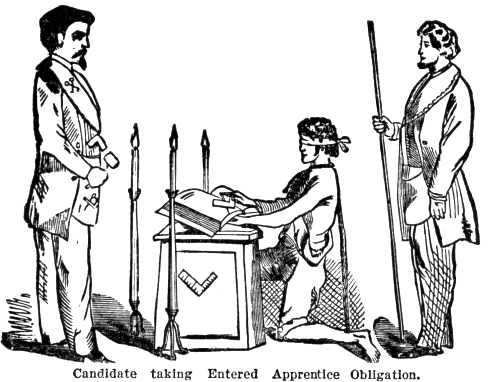 Candidate taking Entered Apprentice Obligation.
Candidate taking Entered Apprentice Obligation.
Worshipful Master to Candidate:—”You will advance to the altar, kneel upon your naked left knee, your right forming a square, your left hand supporting the holy Bible, square and compass, your right resting thereon, in which due form you will say, I, with your name in full, and repeat after me.”
Grip of an Entered Apprentice.—Take hold of each other’s hands as in ordinary hand-shaking and press the top of your thumb hard against the first knuckle-joint of the first finger near the hand. If the person whom you are shaking hands with is a Mason, he will generally return a like pressure on your hand.
p. 106
Entered Apprentice Word—Boaz. It is the name of this grip.
Entered Apprentice Step.—Step off one step with the left foot and bring the heel of your right foot to the hollow of your left.
Next: Fellow Craft Degree
Index
Moe is the founder of GnosticWarrior.com. He is a father, husband, author, martial arts black belt, and an expert in Gnosticism, the occult, and esotericism.


